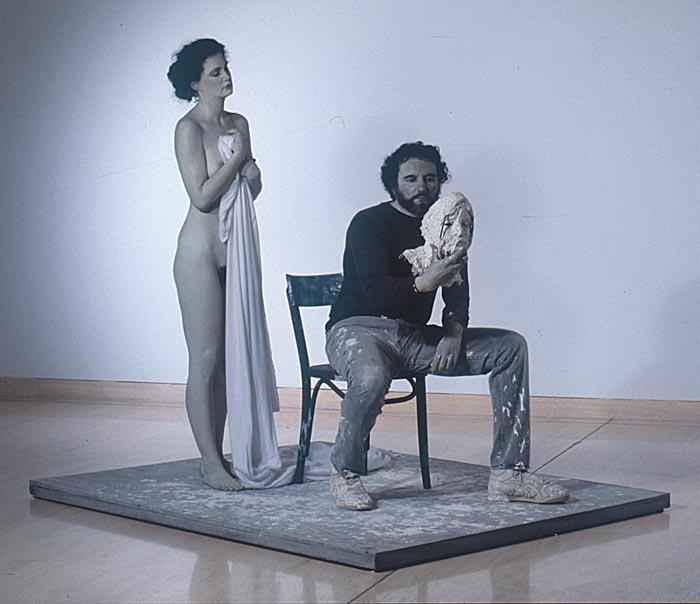JOHN DE ANDREA

Known for his breathtakingly lifelike sculptures of female and male nudes, the photo-realist artist John De Andrea was born in Denver, Colorado in 1941. He studied art at the University of Colorado at Boulder and received his B.F.A. in 1965. Having been given an art scholarship in 1966, he went on to study at the University of New Mexico at Albuquerque through 1968. Currently, the artist lives and creates in Denver.
De Andrea's original media of choice was painting which he studied throughout his college years. At the University of New Mexico he was first intrigued by the idea of sculpture while watching a friend make kayaks by casting with fiberglass. De Andrea made his first casts of human body parts while still in New Mexico, although he finished the pieces with automotive paint as opposed to the oils he used in his later work.
He first exhibited in New York City along with other photo-realist artists that were dominating the art scene in the early 1970's. His first big break was in 1970 when his work was exhibited at the Whitney Annual. The Whitney exhibition snowballed into the 1971 Paris Biennial in France and a show at the Documenta V in Kassel, Germany in 1972.
The work of De Andrea often elicits the first reaction of shock from its viewers. Each piece is a painstakingly realistic sculpture of a nude done in a life size scale. When arranged around a gallery, the figures might be taken for real people at first glance. De Andrea has had to deal with the fact that people often focus only on the nudity of the sculptures and are therefore prone to attach sexual meanings to the pieces that may not be intended.
Generally speaking, the figures' eyes are focusing somewhere on the floor and the faces are apt to show little expression. The figures are very intentionally not looking at the viewer because De Andrea feels that a direct gaze may frighten the on-looker and discourage her or him from looking too long. On occasion, De Andrea has been known to let the figure glance off to the side so that a viewer may be drawn into the sculpture's field of vision as they walk around the piece.
Upon viewing De Andrea's work, it comes as no surprise that each piece takes several months to complete. The artist can generally only complete three to four annually.
Using a working process similar to that of fellow photo realist Duane Hanson and reminiscent of that of Pop artist George Segal and of his own explorations in fiberglass, De Andrea first starts out with a mold. To do this, he uses a real person, usually a woman, although he does occasional sculptures of men, and normally a professional model. He makes his molds from rubber and completes them in several sections of the body. Commonly, there is a mold of the top half, one of the bottom half and always a separate one of the head. Each mold is completed in only 17 or 18 minutes and over several sessions, as he cannot afford for the model to become tired and lose position. The model is then cut out of the mold from the back. De Andrea tries to make as few cuts in the rubber as possible in order to keep all the detail.
The mold is left hanging from the ceiling and must quickly be made rigid so it does not lose its shape. To do this, De Andrea coats it with plaster in many layers and then adds hemp fiber to give the mold extra strength. Heated vinyl acetate is poured into the mold to make the sculpture. While the majority of the body is solid, the head always remains hollow so the artist can later insert eyes. The vinyl is impressively strong and virtually indestructible so that De Andrea has no qualms about knocking the mold off with a sledgehammer. If a piece comes out of the mold with too many bubbles or imperfections, he must start over again.
The sections of the figure are welded together by hot vinyl and then smoothed over. De Andrea uses plastic eyes that he fashions himself in order to get the desired shape and color. He also places acrylic hair strand by strand into the figure\'s head. He chooses not to use real hair because it will degrade over time. Many subtly different shades of hair are used on each piece to achieve the illusion of reality.
De Andrea then paints the figures by first applying a sprayed on base coat of oil paint. Every other detail of the figure is painted on by brush after the first initial layer. So far does De Andrea go in his pursuit of reality that he even paints a network of blue and red veins as another under-layer before applying the finished effect that the viewer sees.
De Andrea feels that it is the painting that truly provides the effect of the sculptures. Like a photo-realist painter, De Andrea treats the surface of his sculpture like a canvas. To some critics, the ultra-real sculptures are evidence of De Andrea\'s exploration and obsession with perfection.
Still others address the seemingly expressionless faces of the figures and declare that they deal with a lack of a soul. De Andrea is never satisfied with his work and is always striving to make it more real with each subsequent sculpture. One can see the progression of the work when looking at his 1970\'s pieces compared to those of today.
Page author: N.G.
